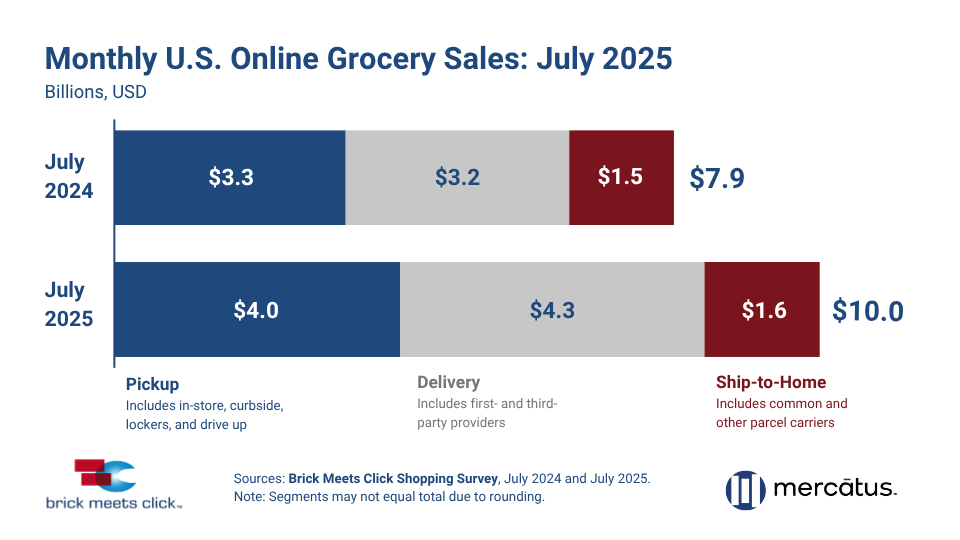eGrocery Sales Jump to $10 Billion in July 2025, Fueled by Record Household Penetration
U.S. online grocery sales totaled $10.0 billion in July 2025; a 26% increase compared to the previous year. This surge was driven by a record number of monthly users, as well as strong order activity and increased spending rates according to the latest Brick Meets Click Grocery Shopper Survey, sponsored by Mercatus.
Key Takeaways from July 2025 eGrocery Performance

The new research shows that all three eGrocery fulfillment methods—Delivery, Pickup, and Ship-to-Home—posted strong results.
- Delivery led the way, with sales jumping 36% year-over-year to $4.3 billion, accounting for more than half of the monthly gains.
- Pickup sales grew by 24% compared to last year, reaching $4.0 billion. This method contributed 38% to the year-over-year sales growth.
- Ship-to-Home sales increased by 10% from July 2024, finishing the month with $1.6 billion.
Record household penetration levels
“The elimination of explicit fees, like the standard delivery cost, via a membership or subscription program, removes a top barrier to increased usage and customers are taking advantage of it,” said David Bishop, Partner, Brick Meets Click. “This tactic is unlocking latent demand for Delivery which is typically viewed as the more convenient but also the more expensive option when compared to Pickup.”
July 2025 set a record for eGrocery penetration as 81 million, or approximately 61% of U.S. households, bought groceries online during the month, whether the order was shipped, picked up, or delivered. Pickup’s monthly active user (MAU) also set a record during the month as more than one-third of all U.S. households used the service method during the month.
Compared to a year ago, the overall number of MAUs climbed almost 11%, fueled by infrequent and/or lapsed users who reengaged with a service while the total pool of households who have ever bought groceries online inched up just 35 basis points.
Higher order frequency rates
The average number of orders per MAU grew by 6.5% compared to July 2024, with consumers in the 30-44 and 45-60 age groups driving the increase.
Average order values climb
The overall average order value (AOV) for eGrocery services increased by 7% year-over-year, largely due to an 8% increase in the AOV for Delivery. This was also influenced by a shift in the user base towards more engaged customers who complete four or more orders with the same service over a three-month period. Research has shown that these more-frequent users consistently spend about 50% more per order than first-time shoppers.
Online share of total grocery spending expands
Total grocery spending in July grew 2.7% versus a year ago while eGrocery spending climbed 26.0% YOY. As a result, eGrocery’s share of total grocery spending jumped more than 300 bps to finish July 2025 at 17.2%, or 14.4% if including only Delivery and Pickup.
Sponsor Message
"In an era where ‘free’ delivery is setting new customer expectations and Walmart’s retail media revenue fuels its competitive edge, regional grocers face mounting pressure to profitably serve shoppers online,” said Mark Fairhurst, Chief Growth Marketing Officer, Mercatus. “Grocery retailers that own and activate their customer data to target and personalize offers—especially for infrequent or lapsed shoppers—can turn renewed engagement into lasting loyalty, defending both sales and margins."
Learn more
The July 2025 eGrocery Sales Report illuminates a dynamic and competitive market. For grocery retailers, understanding these shifts and adapting strategies to meet evolving consumer behaviors will be crucial for sustained success.

.png)





